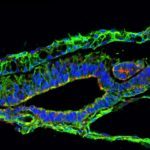Lien vers Pubmed [PMID] – 26395480
Lien DOI – 10.1242/dev.125328
Development 2015 Nov; 142(21): 3734-45
Disrupted ERK1/2 signaling is associated with several developmental syndromes in humans. To understand the function of ERK2 (MAPK1) in the postmigratory neural crest populating the craniofacial region, we studied two mouse models: Wnt1-Cre;Erk2(fl/fl) and Osr2-Cre;Erk2(fl/fl). Wnt1-Cre;Erk2(fl/fl) mice exhibited cleft palate, malformed tongue, micrognathia and mandibular asymmetry. Cleft palate in these mice was associated with delay/failure of palatal shelf elevation caused by tongue malposition and micrognathia. Osr2-Cre;Erk2(fl/fl) mice, in which the Erk2 deletion is restricted to the palatal mesenchyme, did not display cleft palate, suggesting that palatal clefting in Wnt1-Cre;Erk2(fl/fl) mice is a secondary defect. Tongues in Wnt1-Cre;Erk2(fl/fl) mice exhibited microglossia, malposition, disruption of the muscle patterning and compromised tendon development. The tongue phenotype was extensively rescued after culture in isolation, indicating that it might also be a secondary defect. The primary malformations in Wnt1-Cre;Erk2(fl/fl) mice, namely micrognathia and mandibular asymmetry, are linked to an early osteogenic differentiation defect. Collectively, our study demonstrates that mutation of Erk2 in neural crest derivatives phenocopies the human Pierre Robin sequence and highlights the interconnection of palate, tongue and mandible development. Because the ERK pathway serves as a crucial point of convergence for multiple signaling pathways, our study will facilitate a better understanding of the molecular regulatory mechanisms of craniofacial development.

